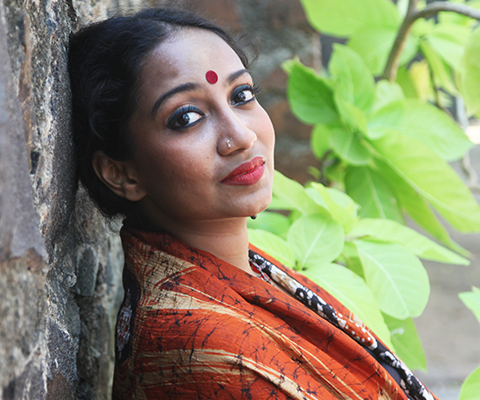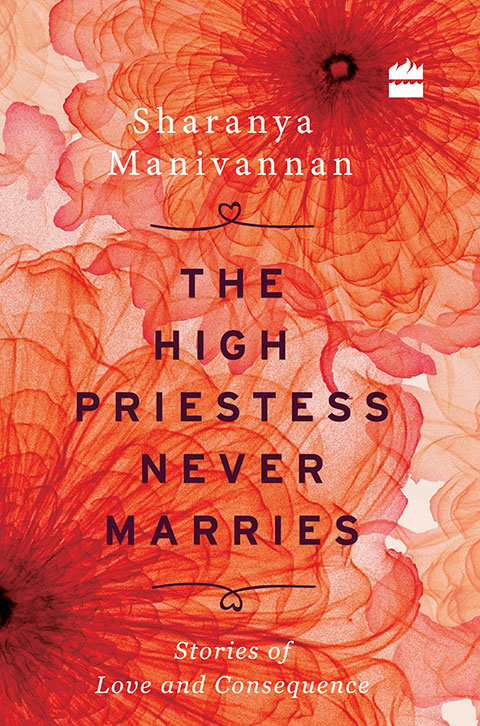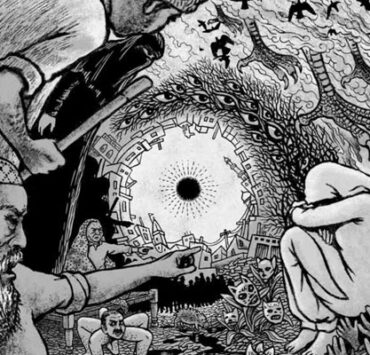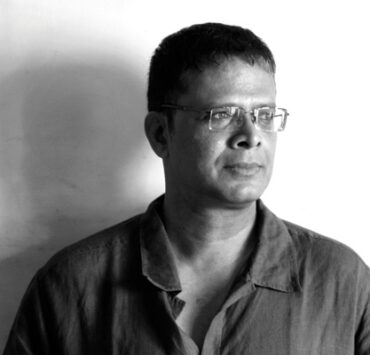Sharanya Manivannan weaves a rich tapestry with the fine threads of love in her newly released book of short fiction titled The High Priestess Never Marries.
The love that permeates these pages is a difficult one. Here, the self is the only constant, longing and heartbreak unearth discomfiting vulnerability, and the heart sings an audacious tune. The impulse of most stories is oriented towards solitude; any inkling of contentment detrimental to the emotional growth the narrator aspires to. Natural rhythms and mythology often conspire to lead the protagonist to extraordinary wisdom, and every dawning is framed in stunning metaphor. It is these that make the fragments of love feel whole.
Read on for excerpts from an exclusive interview with the author about The High Priestess, mythology, her nonfiction, and her relationship with the city of Madras—

“It’s not about what the myths tell you sometimes, but how you tell the myths to yourself.” Photograph by Rahul Dev.
The High Priestess is lucky; she has had the fortune of articulate lovers who have given her beautiful insights into her soul. But, on second thought, they’re perhaps luckier…
She’s lucky in all the stories in which she gets away, or gets what she wants, and most especially in the stories in which she gets what she needs even though she weeps as she gets it. Her lovers are lucky to have known her. What they do with that knowledge is a question of choice, not luck, because I think that’s what she did with the knowledge of having known them, too. She took their stony silences and alchemised them into articulations, insights, other views of the self.
These are love stories about absent lovers, lovers who left, lovers imagined, lovers who did not love back. What The High Priestess Never Marries truly is is a book about solitude and self-possession, because the lovers only traipse through, ultimately. She is the only one who has to live with herself.
The genesis of the book is in these lines from the story ‘Sandalwood Moon’: “And if I could not teach you how to love, I would teach myself how to live alone.”
Madras is now firmly nestled in the geography of love, seduction, and perhaps even wrapped in a delicate existential fabric. How has your relationship with the city evolved?
Madras is the city in which I spent my 20s, and in some ways lost my 20s, too. There are things I know I would have had had I only lived in a city that was kinder and less misogynistic, and I am embittered by those unfulfilled possibilities. Staying and leaving are not simple things for people like me, whose histories are fraught with exile. But I love that line—“nestled in the geography of love, seduction”. This is true. This was the city I was both young enough and old enough in a way I doubt I ever will be again.
When I was a teenager I desperately wanted to live in India, and I still remind myself of that—after all, it’s not often in life that one gets what one wants, however that manifests.
Nine years into living here, I find myself almost as unbelonging as I did when I first moved. But I miss myself as I was at 25—I think I briefly carved a personal niche in which I could be fully myself, but it was not sustainable. The story, ‘Afternoon Sex’, where Antara barters her wild, imaginative life for the scaffolding of marriage? Imagine both—wildness and barter—but without the marriage. Completely unsustainable. I am 31 now and thinking of practical things, of financial obligations and what building alone and getting older in this city are going to look like. Do I want to remain here? No. Will I leave? My heart only asks a question back: “When?” Neither my intuition nor my intelligence answer.
Your emotions are profound, heavy, all consuming. Yet, they are made sense of by the rich imagery you manage to whip up from the mundane, and from the rhythms of the natural world. Is this how you make sense of that which, at the beginning, seems unfathomable?
Yes. That is how I make sense of things, how I understand the world. I put my feet on the earth and into the sea. I seek prayer and music. I weep if I can. I trust. And then I write the truth as I know it. Even in fiction.
You also draw heavily from the cosmos, mythology, embedded customs… does each bear its own kind of wisdom and the potential to uniquely contour (our understanding of) love?
Absolutely. Mythology in particular is deeply consoling. It dislocates universal experience in time and space, which means it is accessible to anyone. The last story I wrote for the book was ‘Ancestress’, which opens on the myth of the goddess Kanyakumari, which I see purely as one of emotional devastation. She is deceived out of marital joy. Many women go to the goddess’ temple, in a place that shares her name, with fertility and matrimonial petitions. Essentially, they ask her for what she was denied. But I identified with her pain. I wondered if those who go to her carry that same empathy for her, or if they only carry to her their rue.
I believe in the healing power of art, and the ways in which narrative can be used to shift and reconcile pain. It’s not about what the myths tell you sometimes, but how you tell the myths to yourself. You can lullaby yourself to sleep on them.
There are very few stories in the collection that do not assume the ‘I’ narration. Did you feel encumbered at certain moments, because as much as the ‘I’ can be freeing, it can be burdensome?
Not at all. I really like to become and immerse myself in a voice, rather than to maintain objective distance. Maybe in other books, though—a few years ago, when you first interviewed me for Helter Skelter, I remember telling you that I looked forward to a long career. I still do. Perhaps that independent third-person narrative is still to come.
Even the saddest of stories in the collection are rendered so beautifully, I couldn’t help but feel buoyant again. How is memory to be annihilated so each love may be seen through the prism it deserves?
What a beautiful question. I find that memory doesn’t need to be annihilated, only trauma and traumatised attachment. There is always more love, if you let it come to you when it will.
Waiting is both bittersweet and dangerous. I am lovelorn for love. I have been between beloveds for a long time. There’s a Jane Hirshfield poem about solitude, with these lines: “Wrong solitude vinegars the soul, right solitude oils it. […] How fragile we are, between the few good moments.” One must carry oneself with care.
I have keenly followed your nonfiction. While your fiction has a deeply empathetic bearing, your nonfiction is pitch-high, often devoid of the restraint your fiction and poetry have. Is this a strategic choice?
By nonfiction I assume you mean my column, The Venus Flytrap, in The New Indian Express. When I first started writing it in 2008, I was happy to have it be an extension of my poetic style, to simply record musings. But this is a highly divisive time, not just in India but elsewhere too, and there’s a real sense of frustration among writers and activists that we aren’t able to get through to a public that doesn’t enjoy reading and seems to be quickly influenced by hate-mongering. I recognise that a newspaper column is a platform that needs to be galvanised for something beyond beauty. So when I write sociopolitical pieces, I’ve learnt to adapt my style so that it more simply and directly gets to the point. Another reason for the straightforward pitch is, simply, word count! But I’ll always be a poet at heart, so the column now is a mix of reflections and polemics.
I have been dying to ask: why kannamma? Or should I say, how did you come to love this endearment?
Kannamma from Subramania Bharati, of course. Tamil is the earliest language of love that I know, the only one that my grandmother (who loved me more than anyone ever has) spoke.
I turned to the eponymous story first, and found, incidentally, that you like your romances anachronistic. When would you have liked to live and love?
I will never know what it’s like to have not known heartbreak. I will never know what it’s like to have been a young mother. I will never know what it’s like to have only loved one person my whole life, or to have known only one home and never lost it. Some of what underpins this book is a sense of what never could have been. So an anachronistic romance to me isn’t one that is boxed into a particular life, but one that gently touches that kind of certainty now and then, an act of belonging.









